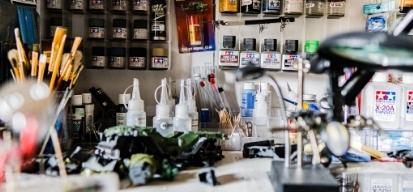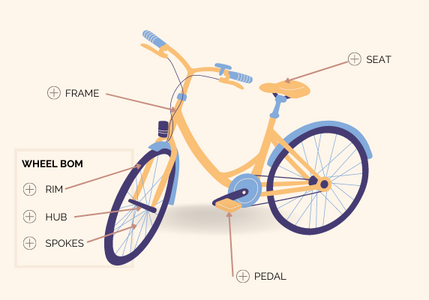What is a Bill of Materials? Examples for Small Manufacturing Businesses
This article explains what bill of materials (BoM) are, why they are important to small manufacturers. We'll also go through some examples of single and multi level Boms.

If you’re a small business manufacturer, then you’ve likely heard the term “bill of materials” bandied about before, and know that it’s in some way important to your business success.
But what is a bill of materials, exactly? This article explains what a bill of materials is, and why it is important for manufacturers large and small.
We’ll also walk through some examples using some typical products so you can start to create your own bill of materials with confidence.
Need to get your raw material and product inventory under control?
Try Craftybase - the inventory and manufacturing solution for DTC sellers. Track raw materials and product stock levels (in real time!), COGS, shop floor assignment and much more.
It's your new production central.
Let’s start with the important BoM definitions so we are all on the same page.
☞ Or, take the easy road and use our award winning Bill of Materials software to generate your BoMs. Free 14 day trial available →
What’s inside this article?
- What is a Bill of Materials (aka a BoM)?
- The anatomy of a BoM
- Simple BoM Examples
- Bill of Materials Example (PDF)
- How to create a BoM yourself
- The importance of creating BoMs for your business
What is a bill of materials?

A Bill of Materials (typically shortened to “BOM” or “BoM”) is a document that lists all the raw materials and components (sub-assemblies) that are needed to make either a single batch of your products.
The anatomy of a BoM

Although it may sound complex, a bom structure is actually quite simple: it’s purely a list (or “bill”) of the items you use to construct your product.
What are the 4 items that make up a bill of materials?
A typical basic BoM format will include the following 4 items:
- The name of the raw material (including a SKU if available)
- The quantity required
- The unit cost
- The labor cost
BoM Notes
For each BOM notes about how to produce your product can also be stored, which can be useful if you are creating documentation for your team. Expanding this documentation into SOPs can then be a good next step.
Units of measurement
It’s also important to note that both the quantity and the unit cost should be expressed in the unit of measure used in your production process.
For some products that require distinct parts, your unit of measure will typically be “each”. For example, if you are making a batch of 100 widgets that each require one screw, your bill of materials line for this material may look something like this:
| SKU | Material | Unit Cost | Quantity | Total Unit Cost |
|---|---|---|---|---|
| 1234-56-789 | Screws | $0.05 | 100 | $500.00 |
For products, like soap, that require raw materials to be measured out then the unit of measure will be “ounces” or some other unit of weight or measure. This unit can be a standard unit of measure or can be something specific and unique to your production process. The important thing with choosing a unit of measure is to make sure it is repeatable (for quality and consistency purposes) and understandable by your team members.
For example, a line for Lye on a bill of materials for a batch of 100 bars of soap may look like this:
| SKU | Material | Unit Cost | Quantity | Total Unit Cost |
|---|---|---|---|---|
| 674-122 | Lye | $0.05 | 400 | $200.00 |
BoM Costings
Your bill of materials should also includes the assembly labor cost.
While internal costs of manufacture are not usually part of your COGS or inventory valuation, including some component of your labor time in your BoMs is helpful as it will give you an accurate picture of your total cost per unit which you can then use to calculate profit margins and decide on pricing.
The total cost for producing the widget is also usually part of the Bill of Materials - this is referred to as your COGM (Cost of Goods Manufactured). It’s a slightly different calculation to your COGS, which we explain in more detail in this article: How to calculate your COGS.
Including packaging in your bill of materials
Packaging materials typically not included in the bill of materials, as they are not considered to be part of the product itself. However, if you are including them for cost or inventory purposes, they can be added as a separate line item on the bill of materials.
Now that we have our bill of materials definitions out of the way, let’s look at some bill of materials examples for different types of products. These should give you a good idea of how to start creating your own bill of materials template for your business.
What are some bill of materials examples?
Simple widget bill of material
Let’s start with a generic example to show you the structure of a bill of material. Assuming you have a product that is made up of three basic parts that are all measured in distinct units, a very simple bill of materials example might look something like this:
Product: Widget
| SKU | Material | Unit Cost | Quantity | Total Unit Cost |
|---|---|---|---|---|
| A | PART A | $2 | 1 | $4 |
| B | PART B | $3 | 2 | $6 |
| C | PART C | $4 | 1 | $4 |
| Labor | $15 | 1 | $15 | |
| Total | $24 | 1 | $24 |
This bill of materials is for a product called a “widget” which is made using the raw materials of Part A, Part B and Part C.
As you can see, the bill of materials for the widget simply lists all the raw materials needed to make the product, as well as the price per unit.
Single level BOM example
Now that we’ve learned the basic components of a manufacturing bom, let’s take a look at real-world example for a bicycle manufacturer.

This BoM example is a single level bill of materials, which means that for this bom level there are no sub-assemblies involved in the production of the final product: all the components are raw materials assumed to be directly purchased and sourced from a supplier (we will cover multi level BOMs in another example below)
The manufacturing bill of materials is as follows:
Product: Bicycle
| SKU | Material | Unit Cost | Quantity | Total Unit Cost |
|---|---|---|---|---|
| FR-01 | Frame | $75.00 | 1 | $75.00 |
| WH-06 | Wheel | $25.00 | 2 | $50.00 |
| ST-11 | Seat | $30.00 | 1 | $30.00 |
| PD-04 | Pedal | $12.00 | 2 | $24.00 |
| LABOR | $20.00 | |||
| Total | $199.00 |
Multi Level Bill of Materials Example
A multi level bom is a more complex bill of materials that involve sub-assemblies.
What are sub-assemblies? Sub-assemblies are products that are made up of multiple raw materials and components, but which are sold as a single unit. In other words, they are partially assembled products.

An example of a sub-assembly for a bicycle manufacturer might be a frame, which is made up of multiple parts such as the tubing, dropouts, and the bottom bracket shell. Another example would be the wheels, which are made up of the rim, spokes, tube, and hub.
In a multi level bill of materials, these sub-assemblies would be listed as components that can be manufactured at a different stage or time to the finished product itself.
A multi level BoM also allows for the assembly labor for the component to be accounted for and included as part of the overall cost of production. This is hugely important as these hidden component costs can be substantial and have impacts on your profit margins.
Let’s say for our bike shop above that they also make the wheels themselves in-house using raw materials. For each bicycle, they now have to complete the “wheel” manufacture before they can complete the overall bicycle. To handle this multi-stage process, the bike workshop will want to create a multi-level BoM.
A multi-level BoM showing the overall bicycle construction (including a subassembly for a wheel) might look something like this:
Bill of Materials for Bicycle
| SKU | Material | Unit Cost | Quantity | Total Unit Cost |
|---|---|---|---|---|
| FR-01 | Frame | $75.00 | 1 | $75.00 |
| WH-06 | Wheel | $54.50 | 2 | $89.00 |
| ST-11 | Seat | $30.00 | 1 | $30.00 |
| PD-04 | Pedal | $12.00 | 2 | $24.00 |
| LABOR | $20.00 | |||
| Total | $199.00 |
Sub-assembly (WH-06 Wheel):
| SKU | Material | Unit Cost | Quantity | Total Unit Cost |
|---|---|---|---|---|
| TR-01 | Tire | $15.00 | 1 | $15.00 |
| TB-22 | Tube | $0.50 | 1 | $0.50 |
| RIM-11 | Rim | $12.00 | 1 | $12.00 |
| SP-04 | Spokes | $0.25 | 48 | $12.00 |
| LABOR | $5.00 | |||
| Total | $44.50 |
The WH-06 Wheel Bom can be made separately to the bicycle Bom, which creates stock of the wheel material for use in the higher level BoM.
Read more: Multilevel Bill of Materials: A Guide for Small Manufacturers (+ Examples)
Now that you know what bill of materials are and how to create them, you can start to build your own with confidence! In the section below, we’ll cover some ways you can automate and better track your bill of materials.
How to create a bill of materials yourself
Now that you understand the basics of a bill of materials, and why they are important, it’s time to start thinking about the process of creating them for your own manufacturing business.
Using PDF BOM templates
The most simplistic way to get up and running with your bill of material creation is to use the old pen and paper method. To do this, we recommend downloading our Bill of Materials Example (PDF) here to get you started.
Our BOM PDF is simple, but contains all the data fields you need to get your BOM game on. From here, you can then start to explore more advanced options like spreadsheets and software (which we will discuss at length below).
Using spreadsheets to create your BOMs
You may now be thinking of firing up a fresh spreadsheet tab in Excel and getting to work in documenting your BoMs. Before you do, it’s important to note that there are a few reasons why using spreadsheets is not the best idea when it comes to tracking your bill of materials:
- They are prone to errors: One small mistake can easily propagate throughout the entire sheet, causing inaccuracies in your data.
- They are time-consuming to update: Every time there is a change in either your material or your product, you will need to go through the entire sheet and update all the relevant information. This can be a very tedious and time-consuming process.
- They are difficult to share: If you need to share your bill of materials with other members of your team, it can be difficult to do so without sending them the entire spreadsheet. This can be a problem if you need to keep certain information confidential.
Nonetheless, if you feel that BOM spreadsheets are the way to go for your business right now, we’ve created a handy free BOM template for Excel and Numbers here →
Why is it important to create a bill of materials?
While creating BoMs may seem to be something only large manufacturing enterprises should do, BoMs are just as critical, if not more so, for small businesses.
After all, if you don’t know what materials you need to make your product, how can you order the correct amount, or plan your production schedule?
Creating a bill of materials has many benefits for small manufacturing businesses, let’s take a look at some of these now:
✅ Track your inventory more accurately
By having a bill of materials, you can track your inventory more accurately as given the components required, you’ll be able to quickly calculate predicted usage against your on-hand stock amounts. This gives you more visibility on your stock availability which prevents stock-outs, and also allows you to take advantage of volume discounts when ordering.
✅ Communicate more effectively with your suppliers
A bill of materials also allows you to communicate your requirements to suppliers more effectively. You’ll be able to quickly send them a list of the materials that you need, and they can provide you with pricing and delivery lead times.
✅ Plan your production more effectively
By having a bill of materials, you can plan your production more effectively as you’ll have a complete list of the materials that you need to make each product. This allows you to schedule your production runs more efficiently, and avoid disruptions caused by missing materials.
✅ Know your manufacturing costs and your profit margins
To price your products correctly, and know your profit margins. To calculate this, you need to understand the cost of the materials that go into each product. By having a bill of materials, you can quickly see your COGM, and price your products accordingly.
✅ Identify ways to optimize your manufacturing and costs
By having a bill of materials, you can also identify ways to optimize your manufacturing process and reduce your costs. For example, if you see that you have a lot of material waste, you can investigate ways to reduce this waste. Or, if you see that you’re using a lot of expensive materials, you can look for ways to substitute these with cheaper alternatives.
✅ Manage your quality control process
Finally, your bill of materials can be used as a quality control tool.
By having a complete list of all the components that go into your product, you can more easily identify which parts may be causing issues or defects. This information can then be used to improve your manufacturing process and allow you refine and produce higher-quality products.
Now that I’ve convinced you of the importance of creating a bill of materials for each of your products, let’s now take a look at the basic BoM structure and the information you’ll need to gather.
How manufacturing software can help your small business
Manufacturing software usually comes under the category of either ERP or MRP software.
These systems are designed to make it easy for businesses to manage their bill of materials, as well as other aspects of their operations.
Some of the benefits of using manufacturing software include:
- Automatic updates: Whenever there is a change in your product, the software will automatically update your bill of materials. This means that you will always have accurate and up-to-date information.
- Easy sharing: You can easily share your bill of materials with other members of your team, as all data is available in the cloud
- Improved collaboration: Manufacturing software often comes with built-in collaboration tools, which make it easy for team members to work together on bill of materials.
If you are looking for manufacturing software that can help you manage your bill of materials and improve your supply chain, consider Craftybase.
Craftybase helps small manufacturers to streamline their bill of materials process by creating and managing boms in one central software platform.
Craftybase offers a number of MRP features that can help you to save time and money, including:
- The ability to create single-level and multi-level bill of materials (known as “recipes”)
- Raw materials and finished product real-time inventory management
- Automatic calculation of your COGM and COGS
- And much more!
If you’re looking for a bill of materials software that can help you to take your manufacturing business to the next level, then be sure to check out Craftybase. Sign up for your free 14 day trial today!
